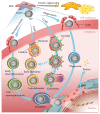Nanoparticles-Assisted Stem Cell Therapy for Ischemic Heart Disease
- PMID: 26839552
- PMCID: PMC4709699
- DOI: 10.1155/2016/1384658
Nanoparticles-Assisted Stem Cell Therapy for Ischemic Heart Disease
Abstract
Stem cell therapy has attracted increasing attention as a promising treatment strategy for cardiac repair in ischemic heart disease. Nanoparticles (NPs), with their superior physical and chemical properties, have been widely utilized to assist stem cell therapy. With the help of NPs, stem cells can be genetically engineered for enhanced paracrine profile. To further understand the fate and behaviors of stem cells in ischemic myocardium, imaging NPs can label stem cells and be tracked in vivo under multiple modalities. Besides that, NPs can also be used to enhance stem cell retention in myocardium. These facts have raised efforts on the development of more intelligent and multifunctional NPs for cellular application. Herein, an overview of the applications of NPs-assisted stem cell therapy is given. Key issues and future prospects are also critically addressed.
Figures



Similar articles
-
Fluorescent conjugated polymer nanovector for in vivo tracking and regulating the fate of stem cells for restoring infarcted myocardium.Acta Biomater. 2020 Jun;109:195-207. doi: 10.1016/j.actbio.2020.04.010. Epub 2020 Apr 12. Acta Biomater. 2020. PMID: 32294553
-
Engineered Nanoparticles: Their Properties and Putative Applications for Therapeutic Approaches Utilizing Stem Cells for the Repair of Atherosclerotic Disease.Curr Drug Targets. 2018;19(14):1639-1648. doi: 10.2174/1389450118666171027111528. Curr Drug Targets. 2018. PMID: 29076427 Review.
-
Functional Nanoparticles and their Interactions with Mesenchymal Stem Cells.Curr Pharm Des. 2017;23(26):3814-3832. doi: 10.2174/1381612823666170622110654. Curr Pharm Des. 2017. PMID: 28641542 Review.
-
Fates of Fe3O4 and Fe3O4@SiO2 nanoparticles in human mesenchymal stem cells assessed by synchrotron radiation-based techniques.Biomaterials. 2014 Aug;35(24):6412-21. doi: 10.1016/j.biomaterials.2014.04.052. Epub 2014 May 10. Biomaterials. 2014. PMID: 24814428
-
C-Kit Positive Cardiac Stem Cells and Bone Marrow-Derived Mesenchymal Stem Cells Synergistically Enhance Angiogenesis and Improve Cardiac Function After Myocardial Infarction in a Paracrine Manner.J Card Fail. 2017 May;23(5):403-415. doi: 10.1016/j.cardfail.2017.03.002. Epub 2017 Mar 8. J Card Fail. 2017. PMID: 28284757
Cited by
-
Increasing the Efficacy of Stem Cell Therapy via Triple-Function Inorganic Nanoparticles.ACS Nano. 2019 Jun 25;13(6):6605-6617. doi: 10.1021/acsnano.9b00653. Epub 2019 Jun 17. ACS Nano. 2019. PMID: 31188564 Free PMC article.
-
Cardiovascular Regenerative Technologies: Update and Future Outlook.Transfus Med Hemother. 2016 Jul;43(4):291-296. doi: 10.1159/000447749. Epub 2016 Jul 21. Transfus Med Hemother. 2016. PMID: 27721705 Free PMC article. Review.
-
Nanomedicine applied to cardiovascular diseases: latest developments.Ther Adv Cardiovasc Dis. 2017 Apr;11(4):133-142. doi: 10.1177/1753944717692293. Epub 2017 Feb 15. Ther Adv Cardiovasc Dis. 2017. PMID: 28198204 Free PMC article. Review.
-
Enhanced non-viral gene delivery by coordinated endosomal release and inhibition of β-tubulin deactylase.Nucleic Acids Res. 2017 Apr 7;45(6):e38. doi: 10.1093/nar/gkw1143. Nucleic Acids Res. 2017. PMID: 27899629 Free PMC article.
-
Autologous Bone Marrow-Derived Stem Cells for Treating Diabetic Neuropathy in Metabolic Syndrome.Biomed Res Int. 2017;2017:8945310. doi: 10.1155/2017/8945310. Epub 2017 Oct 1. Biomed Res Int. 2017. PMID: 29098161 Free PMC article. Review.
References
-
- Deb S., Wijeysundera H. C., Ko D. T., Tsubota H., Hill S., Fremes S. E. Coronary artery bypass graft surgery vs percutaneous interventions in coronary revascularization: a systematic review. Journal of the American Medical Association. 2013;310(19):2086–2095. doi: 10.1001/jama.2013.281718. - DOI - PubMed
Publication types
LinkOut - more resources
Full Text Sources
Other Literature Sources

